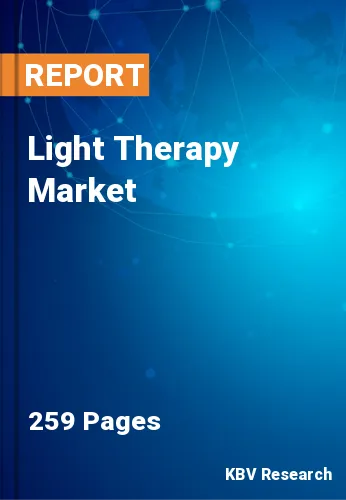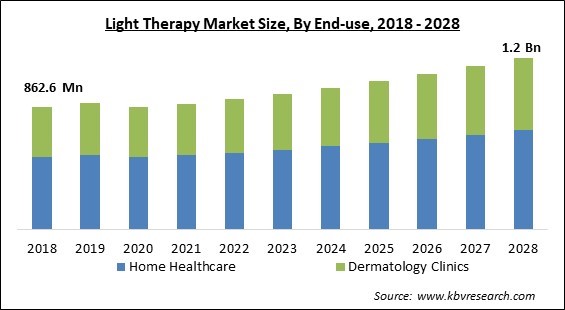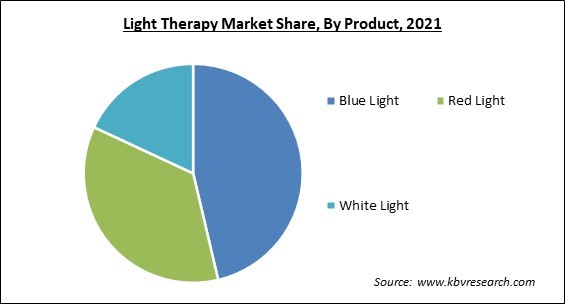
The Global Light Therapy Market size is expected to reach $1.2 billion by 2028, rising at a market growth of 4.7% CAGR during the forecast period.
Light therapy or phototherapy or heliotherapy is defined as the intentional, regular exposure to bright light to treat various medical conditions. This therapy method particularly treats seasonal affective disorder (SAD) as well as problems with the circadian rhythm that control sleep and wakefulness. In addition, the use of UV light to treat skin disorders like neurodermatitis, acne vulgaris, psoriasis, and eczema is known as ultraviolet (UV) light therapy.

Light therapy treats medical illnesses such as neurological disorders, skin problems, jaundice, and others by using sunlight, light-emitting diodes (LED), fluorescent light bulbs, and other sources of light. The therapy makes use of visible light with a range of wavelengths that have beneficial effects on human anatomies, such as red light, blue light, green light, and near-infrared light.
The cells' mitochondria are targeted by red and near-infrared light, which increases cellular energy production and has a therapeutic effect on the body. The green light has been demonstrated to be effective in lowering the frequency and severity of migraines, and blue light has an antibacterial impact, making it usable to treat skin conditions like acne.
Cells present in the retina, namely photosensitive ganglion cells, manages melatonin, a sleep-regulating hormone whose production is inhibited by light and promoted by darkness. The opposite is somewhat true for serotonin, a hormone that has been associated with mood disorders. Therefore, light boxes that provide extremely particular sorts of artificial lighting to the retina are effective for the aim of modifying melatonin levels or timing.
The COVID-19 outbreak has had an influence on almost all businesses. The need for light treatment has significantly increased across many industries, particularly the medical and healthcare industry since the coronavirus crisis forced communities to lockdown and closely adhere to social distance laws. The fundamental cause of the rising demand for light therapy is the rise in depressive disorders since the lockdown era. For instance, the World Health Organization (WHO) reported that depression prevalence increased globally by 25% in 2021. The COVID-19 pandemic therefore hastened the expansion of the light therapy demand.
Neonatal jaundice can be successfully treated with phototherapy. The newborns receive this treatment, where they are subjected to fluorescent light that aids in hastening their recovery. Jaundice in babies is typical, but if it lasts for a long time, doctors will employ phototherapy equipment to cure the condition. A pediatric medicine journal revealed that more than half of babies experience jaundice. Similarly, the National Health Service estimates that 6 out of 10 babies are at risk of developing jaundice. In light of this, market growth is anticipated throughout the forecast period.
There are connections between physical health and depression. For instance, depression may also result from CVD or cardiovascular diseases and vice versa. According to projections from the World Bank, untreated mental illnesses and depression might result in significant economic losses globally. As a result, it is anticipated that the use of light therapy will increase dramatically in the future. In addition, light therapy is known to treat seasonal affective disorders (SADs) in particular by raising serotonin levels. Therefore, the help of light therapy in treating depression, SAD, and other mood disorders are promoting the growth of the market.

Long-term exposure also raises the possibility of getting skin cancer. Since the treatment results in skin lesions, redness, irritation, and rashes, patients with skin cancer and systemic lupus erythematosus should refrain from receiving it. However, with the use of the right light intensity and a controlled therapy duration, together with growing research and improvements, the adverse effects can be reduced, and the performance can be enhanced. But as of now, this therapy's adverse effect is hampering the market's growth.
Based on product, the light therapy market is categorized into light box, floor & desk lamps, handheld devices for skin treatment, light visor, and light therapy lamps. The floor and desk lamps segment procured a considerable growth rate in the light therapy market in 2021. The market's expansion can be attributed to the surge in demand for convenient and affordable floor and desk lamps. It is anticipated that the availability of a vast selection of desk lamps capable of producing powerful light would expand the sector's size. Aspects of floor and desk lights that are likely to promote product adoption include their dazzling light emission and wide-angle adjustments.
On the basis of application, the light therapy market is divided into psoriasis, vitiligo, eczema & acne vulgaris, and sleeping disorders. The vitiligo segment witnessed a significant revenue share in the light therapy market in 2021. Around the world, vitiligo, a disorder that occurs when the skin keeps losing its pigment-producing cells, is waning. The usage of phototherapy is anticipated to rise because it has been demonstrated to stop or slow down the advancement of vitiligo. The market is therefore anticipated to grow over the projected period as a result of the aforementioned factors.
Based on type, the light therapy market is segmented into blue light, red light, and white light. The blue light segment garnered the maximum revenue share in the light therapy market in 2021. Blue light treatment is used to treat a number of ailments, including depression, seasonal affective disorder, skin disorders, and acne. The length of the therapy session might range between 15 and 90 minutes, depending on the disease and treatment area. The demand is anticipated to be driven by studies suggesting that blue light therapy is beneficial in treating melanoma.
On the basis of end-use, the light therapy market is bifurcated into dermatology clinics and home healthcare. The home healthcare segment acquired the highest revenue share in the light therapy market in 2021. The segment is being driven by rising consumer awareness and technology developments like remote patient monitoring. The accessibility of phototherapy devices for use in home healthcare settings and the growing public awareness of phototherapy technology. Additionally, according to the National Psoriasis Foundation, home UVB phototherapy can be both practical and affordable for treating psoriasis.
| Report Attribute | Details |
|---|---|
| Market size value in 2021 | USD 888.5 Million |
| Market size forecast in 2028 | USD 1.2 Billion |
| Base Year | 2021 |
| Historical Period | 2018 to 2020 |
| Forecast Period | 2022 to 2028 |
| Revenue Growth Rate | CAGR of 4.7% from 2022 to 2028 |
| Number of Pages | 259 |
| Number of Table | 480 |
| Report coverage | Market Trends, Revenue Estimation and Forecast, Segmentation Analysis, Regional and Country Breakdown, Companies Strategic Developments, Company Profiling |
| Segments covered | Product, Application, Light Type, End-use, Region |
| Country scope | US, Canada, Mexico, Germany, UK, France, Russia, Spain, Italy, China, Japan, India, South Korea, Singapore, Malaysia, Brazil, Argentina, UAE, Saudi Arabia, South Africa, Nigeria |
| Growth Drivers |
|
| Restraints |
|
On the basis of region, the light therapy market is analyzed across North America, Europe, Asia Pacific, and LAMEA. The North America segment witnessed the largest revenue share in the light therapy market in 2021. This expansion is attributable to an increase in psoriasis cases and SAD/winter blues symptoms. Under medical supervision, light treatment involves subjecting the skin to UV light from artificial sources. As a result, inflammation is decreased, skin cell proliferation is slowed, and symptoms are improved using UVB, UVA, or their combination. A significant proportion of people in Canada suffer from psoriasis, as stated by Canadian Dermatology Association, which is expanding the market for medical devices.
Free Valuable Insights: Global Light Therapy Market size to reach USD 1.2 Billion by 2028
The market research report covers the analysis of key stake holders of the market. Key companies profiled in the report include Beurer GmBH, Johnson & Johnson, Koninklijke Philips N.V., Biophotas, Inc. (Celluma), Nature Bright Company, Outside In (Cambridge) Ltd. (Lumie), Northern Light Technologies, Inc., Verilux, Inc. (Bear Down Brands, LLC), The Daylight Company Limited, and Theralight LLC.
By End-use
By Application
By Light Type
By Product
By Geography
The global Light Therapy Market size is expected to reach $1.2 billion by 2028.
Increasing use of light therapy in the treatment of neonatal jaundice are driving the market in coming years, however, Potential skin damage and side effects restraints the growth of the market.
Beurer GmBH, Johnson & Johnson, Koninklijke Philips N.V., Biophotas, Inc. (Celluma), Nature Bright Company, Outside In (Cambridge) Ltd. (Lumie), Northern Light Technologies, Inc., Verilux, Inc. (Bear Down Brands, LLC), The Daylight Company Limited, and Theralight LLC.
The Handheld Devices for Skin Treatment segment is generating highest revenue share in the Global Light Therapy Market by Product in 2021 thereby, achieving a market value of $307.2 million by 2028.
The Sleeping Disorders segment is leading the Global Light Therapy Market by Application in 2021 thereby, achieving a market value of $333 million by 2028.
The North America market dominated the Global Light Therapy Market by Region in 2021, and would continue to be a dominant market till 2028; thereby, achieving a market value of $448.8 million by 2028.
Our team of dedicated experts can provide you with attractive expansion opportunities for your business.
